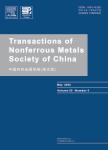版权所有:内蒙古大学图书馆 技术提供:维普资讯• 智图
内蒙古自治区呼和浩特市赛罕区大学西街235号 邮编: 010021

作者机构:State Key Laboratory of Mechanical TransmissionSchool of Material Science and EngineeringChongqing UniversityChongqing 400044China State Key Laboratory of Materials Processing and Die & Mould TechnologyHuazhong University of Science and TechnologyWuhan 430074China Key Laboratory of Advanced Reactor Engineering and Safety of Ministry of EducationCollaborative Innovation Center of Advanced Nuclear Energy TechnologyInstitute of Nuclear and New Energy TechnologyTsinghua UniversityBeijing 100084China
出 版 物:《Transactions of Nonferrous Metals Society of China》 (中国有色金属学报(英文版))
年 卷 期:2019年第29卷第7期
页 面:1449-1464页
核心收录:
学科分类:08[工学] 080502[工学-材料学] 0805[工学-材料科学与工程(可授工学、理学学位)]
基 金:Project(cstc2018jcyj AX0459)supported by Chongqing Basic Research and Frontier Exploration,China Project(P2017-020)supported by Open Fund Project of State Key Laboratory of Materials Processing and Die&Mould Technology,China Project(SKLMTZZKT-2017M15)supported by Research Project of State Key Laboratory of Mechanical Transmission,China
主 题:nickel-based superalloy deformation activation energy processing map dynamic recrystallization
摘 要:The determination of intrinsic deformation parameters inducing grain refinement mechanism of dynamic recrystallization (DRX) contributes to the relative forming process design. For Ni80A superalloy, the processing maps were constructed by the derivation of the stress-strain data coming from a series of isothermal compression tests at temperatures of 1273^-1473 K and strain rates of 0.01-10 s^-1. According to the processing maps and microstructural validation, the deformation parameter windows with DRX mechanism were separated in an innovative deformation mechanism map. In addition, the deformation activation energy representing deformation energy barrier was introduced to further optimize such windows. Finally, the enhanced processing maps were constructed and the parameter domains corresponding to DRX mechanism and lower deformation barrier were determined as follows: at ε=0.3, domains: 1296-1350 K, 0.056-0.32 s^-1 and 1350-1375 K, 0.035-0.11 s^-1;at ε=0.5, domains: 1290-1348 K, 0.2-0.5 s^-1 and 1305-1370 K, 0.035-0.2 s^-1;at ε=0.7, domains: 1290-1355 K, 0.042-0.26 s^-1;at ε=0.9, domains: 1298-1348 K, 0.037-0.224 s^-1.